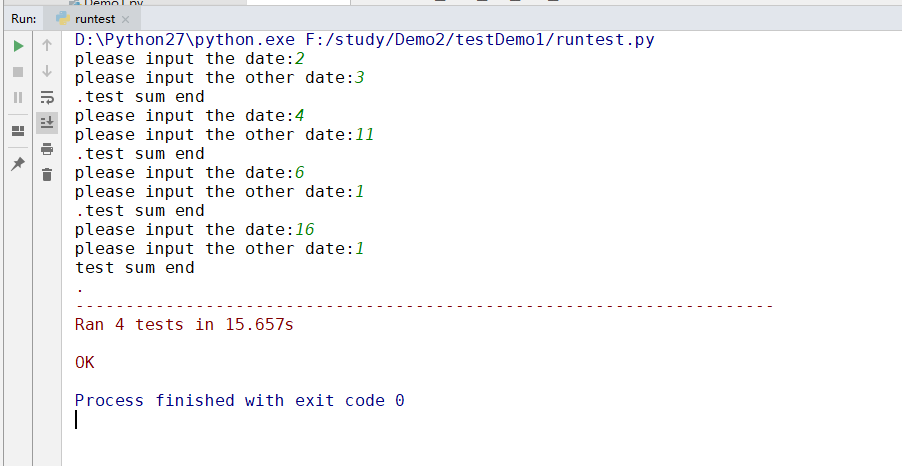Selenium 2自动化测试实战29(组织单元测试用例和discover更多测试用例)
一、组织单元测试用例
看看unittest单元测试框架是如何扩展和组织新增的测试用例
以之前的calculator.py文件为例,为其扩展sub()方法,用来计算两个数相减的结果。
#coding:utf-8
#计算器类
class Count():
def __init__(self,a,b):
self.a=int(a)
self.b=int(b) #计算加法
def sum(self):
return self.a+self.b #计算减法
def sub(self):
return self.a-self.b
因为对计算器类又新增了减法功能(sub),所以需要针对新功能编写测试用例,扩展后的test.py如下
#coding:utf-8
from Demo1 import Count
import unittest class TestSum(unittest.TestCase): def setUp(self):
a = input("please input the date:")
self.a = int(a)
b = input("please input the other date:")
self.b = int(b) def testSum(self):
self.assertEqual((Count(self.a,self.b).sum()),5,msg="the date is not Equal") def testSum2(self):
self.assertEqual((Count(self.a,self.b).sum()),15,msg="the date is not Equal") def tearDown(self):
print"test sum end" class TestSub(unittest.TestCase):
def setUp(self): a = input("please input the date:")
self.a=int(a)
b = input("please input the other date:")
self.b = int(b) def testSub(self):
self.assertEqual((Count(self.a,self.b).sub()), 5, msg="the date is not Equal") def testSub2(self):
self.assertEqual((Count(self.a,self.b).sub()), 15, msg="the date is not Equal") def tearDown(self):
print"test sub end" if __name__=="__main__":
#构造测试集
suite=unittest.TestSuite()
suite.addTest(TestSum("testSum"))
suite.addTest(TestSum("testSum2"))
suite.addTest(TestSub("testSub"))
suite.addTest(TestSub("testSub2")) #运行测试集
runner=unittest.TextTestRunner()
runner.run(suite)
上例中创建了TestAdd()和TestSub()两个测试类,分别测试calculator.py文件中的add()和sub()两个功能。通过TestSuite类的addTest()方法把不同测试类中的测试方法组装到测试套件中。
运行结果如下所示:
D:\Python27\python.exe F:/study/Demo2/testDemo1/test.py
please input the date:2
please input the other date:3
test sum end
.please input the date:4
please input the other date:5
Ftest sum end
please input the date:6
please input the other date:1
.test sub end
please input the date:20
please input the other date:10
test sub end
F
======================================================================
FAIL: testSum2 (__main__.TestSum)
----------------------------------------------------------------------
Traceback (most recent call last):
File "F:/study/Demo2/testDemo1/test.py", line 18, in testSum2
self.assertEqual((Count(self.a,self.b).sum()),15,msg="the date is not Equal")
AssertionError: the date is not Equal ======================================================================
FAIL: testSub2 (__main__.TestSub)
----------------------------------------------------------------------
Traceback (most recent call last):
File "F:/study/Demo2/testDemo1/test.py", line 35, in testSub2
self.assertEqual((Count(self.a,self.b).sub()), 15, msg="the date is not Equal")
AssertionError: the date is not Equal ----------------------------------------------------------------------
Ran 4 tests in 21.417s FAILED (failures=2) Process finished with exit code 0
通过测试结果看到,setUp()和tearDown()方法分别作用于每个测试用例的开始与结束。尝试着封装一个自己的测试类。
#test.py
#coding:utf-8
import unittest
from Demo1 import Count class Mytest(unittest.TestCase): def setUp(self):
a = input("please input the date:")
self.a = int(a)
b = input("please input the other date:")
self.b = int(b) def tearDown(self):
print"test sum end" class TestSum(Mytest): def testSum(self):
self.assertEqual((Count(self.a,self.b).sum()),5,msg="the date is not Equal") def testSum2(self):
self.assertEqual((Count(self.a,self.b).sum()),15,msg="the date is not Equal") class TestSub(Mytest):
def testSub(self):
self.assertEqual((Count(self.a,self.b).sub()), 5, msg="the date is not Equal") def testSub2(self):
self.assertEqual((Count(self.a,self.b).sub()), 15, msg="the date is not Equal") if __name__=="__main__":
# 构造测试集
suite = unittest.TestSuite()
suite.addTest(TestSum("testSum"))
suite.addTest(TestSum("testSum2"))
suite.addTest(TestSub("testSub"))
suite.addTest(TestSub("testSub2")) # 运行测试集
runner = unittest.TextTestRunner()
runner.run(suite)
创建MyTest()类的好处显而易见,对于测试类和测试方法来说,应将注意力放在具体用例的编写上,不需要关心setUp()和tearDown()所做的事情,不过,前提条件是setUp()和tearDown()所做的事情是每个用例都需要的。
二、discover更多测试用例
对上例中test.py文件的测试用例进行拆分,拆分后的目录结果如下:
Testpro/
--count.py
--testsum.py
--testsub.py
--runtest.py
文件拆分后的代码如下:
#count.py
#coding:utf-8
#计算器类
class Count():
def __init__(self,a,b):
self.a=int(a)
self.b=int(b) #计算加法
def sum(self):
return self.a+self.b #计算减法
def sub(self):
return self.a-self.b
#testsum.py
#coding:utf-8
from Demo1 import Count
import unittest class TestSum(unittest.TestCase):
def setUp(self):
a = input("please input the date:")
self.a = int(a)
b = input("please input the other date:")
self.b = int(b) def tearDown(self):
print"test sum end" def testSum(self):
self.assertEqual((Count(self.a,self.b).sum()),5,msg="the date is not Equal") def testSum2(self):
self.assertEqual((Count(self.a, self.b).sum()),15, msg="the date is not Equal") if __name__=="__main__":
unittest.main()
#testsub.py
#coding:utf-8
from Demo1 import Count
import unittest class TestSub(unittest.TestCase):
def setUp(self):
a = input("please input the date:")
self.a = int(a)
b = input("please input the other date:")
self.b = int(b) def tearDown(self):
print"test sum end" def testSub(self):
self.assertEqual((Count(self.a,self.b).sub()),5,msg="the date is not Equal") def testSub2(self):
self.assertEqual((Count(self.a, self.b).sub()),15, msg="the date is not Equal") if __name__=="__main__":
unittest.main()
#runtest.py
#coding:utf-8
import unittest
#加载测试文件
import testsum
import testsub #构造测试集
suite=unittest.TestSuite()
suite.addTest(testsum.TestSum("testSum"))
suite.addTest(testsum.TestSum("testSum2"))
suite.addTest(testsub.TestSub("testSub"))
suite.addTest(testsub.TestSub("testSub2")) #执行测试
if __name__=="__main__":
runner=unittest.TextTestRunner()
runner.run(suite)
运行结果如下:

这样的拆分带来了好处,可以根据不同的功能创建不同的测试用例,甚至是不同的测试目录,测试文件中还可以将不同的小功能划分为不同的测试类,在类下编写测试用例,整体结构更清晰。
但是这样还是没有解决添加用例的问题,此时使用TestLoader类中提供的discover()方法可以解决这个问题。
TestLoader
该类负责根据各种标准加载测试用例,并将它们返回给测试套件,正常情况下,不需要创建这个类的实例。unittest提供了可以共享的defaultTestLoader类,可以使用其子类和方法创建实例,discover()方法就是其中之一。 discover(start_dir,pattern=‘test*.py’,top_level_dir=None)
找到指定目录下所有测试模块,并可递归查到子目录下的测试模块,只有匹配到文件名才能加载。如果启动的不是顶层目录,那么顶层目录必须单独指定。 start_dir:要测试的模块名或测试用例目录。 pattern=‘test*.py’:表示用例文件名的匹配原则。此处匹配文件名以“test”开头的“.py"类型的文件,星号“*”表示任意多个字符。 top_level_dir=None:测试模块的顶层目录,如果没有顶层目录,默认为None。
现在通过discover()方法重新实现runtest.py文件的功能。
#runtest.py
#coding:utf-8
import unittest #定义测试用例的目录为当前目录
test_dir='./'
discover=unittest.defaultTestLoader.discover(test_dir,pattern='test*.py') if __name__=="__main__":
runner=unittest.TextTestRunner()
runner.run(discover)
Discover()方法会自动根据测试目录(test_dir)匹配查找测试用例文件(test*.py),并将查找到的测试用例组装到测试套件中,因此,可以直接通过run()方法执行discover,大大简化了测试用例的查找与执行。
最新文章
- 自定义圆形控件RoundImageView并认识一下attr.xml
- jsf简介
- investopedia level 2
- Roman to Integer -- LeetCode 13
- jquery怎么实现跨域的访问呢?与别人提供的接口连接
- Linux - wxWidgets安装和编译HelloWorld
- linux 5 配置xmanager
- 重看Decorator Pattern,联想到Delegate传递及Flags Enum--欢迎拍砖!
- poj 2318 TOYS
- 安卓开机启动service后台运行
- 整理:C#写ActiveX, 从代码到打包到签名到发布的示例
- digitalocean网站打不开,大陆无法正常访问怎么办?
- List<T>转换为ObservableCollection<T>
- [C#].Net Core 获取 HttpContext.Current 以及 AsyncLocal 与 ThreadLocal
- Bootstrap 4,“未捕获错误:Bootstrap工具提示需要Tether(http://github.hubspot.com/tether/)”
- Mac OS X系统下,svn: Can't remove file Operation not permitted.解决方案
- gzip对字符串的压缩和解压
- 20165223 week3蓝墨云测试总结
- constructor与prototype
- [php] thinkphp基于Http类 下载文件